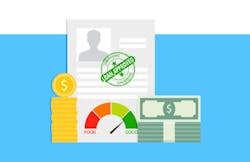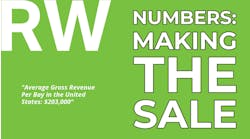The process of applying for business loans isn’t particularly fun or glamorous, but learning it has allowed shop owner Jon Thompson to build the strong chain of shops he has today.
Through a variety of acquisitions and expansions, Thompson now has 14 Butitta Brothers locations throughout Illinois and Wisconsin.
After some rough patches early on, Thompson is now adept at applying for and getting approved for business loans. Almost all of these have been from acquiring other businesses, which provide their own challenges.
“At the end of the day, the banks won’t loan you money if you can’t pay it back,” Thompson says. “There’s a formula that occurs.”
While Thompson is in an atypical position from most shop owners with the amount of businesses he owns now, the process he followed, especially with his first acquisition, is still applicable to any shop owner looking for a business loan to acquire another business.
He lists the steps he took to get a business loan to acquire his first business and build out his first expansion.
The Backstory
Thompson’s first experience with a business loan in the automotive industry was when he bought out the six-location Butitta Brothers in 2005.
Before acquiring Butitta Brothers, Thompson spent 20 years in the steel industry, working his way up into various management positions. However, Thompson always had aspirations to open his own business and when he heard one of his friends planned to sell the business, he thought they were similar enough, and decided to take the jump.
Thompson was going into a completely new industry, and had to ask the bank for a substantial amount of money to purchase the business. Naturally, this made most of the banks he approached uneasy, especially the bigger banks who were worried they wouldn’t be able to get their money back from a new business owner.
“I got told ‘no’ probably four or five times, where they felt like I was too high of a risk,” Thompson says.
He finally was able to get a seven-year loan, partially financed by the seller, partially financed from the bank, and partially financed from the Small Business Association.
The Problem
Thompson waited things out with his first business for a while in an effort to learn the business, master running a multi-location operation, earn trust with his staff and stabilize operations. Two years later, in 2007, he felt he was ready to expand and began entering negotiations to purchase a nearby shop.
This, however, again required a business loan, but since he had more money to put down, he was able to reduce the terms to five years, with a traditional loan straight through the bank. While he had knowledge about obtaining a loan from his previous experience, that process was arduous and filled with ups and downs and significant rejection.
This time, he wanted to avoid all of that. Plus, his business was in a different place than it was two years prior. He had six locations, was a successful shop operator and had more collateral to work with than before. While this was certainly an advantage, it also required a wholly different process. This included negotiating a fair price for the acquisition, finding the right bank, and gathering all the right documents.
The Solution
Find a fair acquisition price:
When Thompson acquired the business for his first expansion, he had to make sure he acquired it for a price fair to both him and the seller. He says it’s important that the bank sees you’re acquiring the business for a fair price, as well, as they’re unlikely to offer a loan if you pay too much.
Basically, the main question he needed to ask was, what is a fair price for the business and all of its assets? He looked up what the fair market value was for the equipment in the shop, and the fair market value for the inventory they had, and brought that to the seller when negotiating.
Find the right bank:
When trying to find a bank for an initial expansion, Thompson suggests shop owners shop around with four or five banks, trying to find the best financial terms and the best interest rate. He suggests reaching out to a local community bank before trying to get a loan from a bigger banking institution.
“Banks change, and they might be more flexible with terms if they’re actively seeking new business,” Thompson says. “But they won’t always tell you that up front.”
In this particular instance, Thompson used the same bank as he did with his first loan, as it had the best interest rates, and he agreed with the terms, which gave him a five-year commitment rather than a seven year.
Have a concrete business plan:
When Thompson went to the bank for his first loan, he put together a written business plan with spreadsheets from the business he was acquiring, and projections on where he planned the business to go in the next few years.
When applying for a loan for his first acquisition, Thompson had collateral with his previous six locations, and more trust and rapport with the bank. When going back to the bank for his second loan, he still had to provide a spreadsheet with financials for Butitta Brothers, but didn’t have to provide a full list of projections.
For anyone applying for a business loan for the first time, Thompson says you need a written plan with your qualifications, history as a business owner, and where you see the business going forward.
“They’re going to want to know what your projections are, what your plan is for the future, how you’re going to make your money, and what your business is all about,” Thompson says.
Gather the right documents:
Thompson says it’s vital to have documents regarding your equipment, inventories, and sales.
“They’ll want to see your income, your finances, and if you have any other business partnerships going on,” Thompson says.
Additionally, Thompson had to gather three years of financial data from the existing business he was acquiring, which he brought to the bank in a binder. That included three years of tax returns, accounts receivable, a P&L statement and a balance sheet.
The Aftermath
Thompson has gotten so familiar with the process, that he says it’s now a bit repetitive. Now he’s built up that collateral with his previous locations and additional buildings, it’s much easier for him to apply for, and be approved for his business loans.
He hasn’t just stuck with one bank either—he’s shopped around for different banks to find the best fit for a particular acquisition, and find the best interest rate.
Just a year ago, Thompson applied for a loan to acquire his 14th location. He says he was able to ask for a larger line of credit, which he’s been able to use on any aspect of his business.
The Takeaway
When prepping for an expansion or a business loan, Thompson says it’s vital to know your business, and know your numbers. Additionally, he says you need to be perseverant, especially with your initial loan applications.
“Don’t give up, and don’t take it personal. Although they’ll tell you you’ll have to sign a personal guarantee,” Thompson says. “The bank’s just trying to make sure you’ll be able to pay back that note. It also protects you—sometimes it’s a case where the numbers just don’t add up. They’ve seen everything.”
SHOP STATS: Butitta Brothers Corporate Headquarters: Wafford, Ill. Operator: Jon Thompson Average Monthly Car Count: 3,000 for all 14 shops Staff Size: 70 Shop Size: 4,000 square feet each Annual Revenue: $10 million for all 14 shops
Expert Advice: Nathan Abadi
Nathan Abadi is the president of Excel Capital Management, which offers alternative lending and financial solutions to businesses, including many in the automotive aftermarket. He gives some major tips any shop owner should think about when applying for a loan to acquire another business.—
The most important thing is to have a solid game plan put together. A business plan with projections, things of that nature. Banks don’t really like lending to people without histories. Obviously there’s exceptions that can be made with a solid business plan or projections with the use of capital. Putting that all into a detailed presentation.
It makes it a lot easier if they’re a manager, previous owner in the company. If they weren’t there needs to be a solid plan put together with forecasts. Also like to see the statements, tax returns for the business that was purchased.
Obviously credit is important. If someone is going to attempt to purchase a business, and they have a sub 620-credit score, it’ll be almost impossible. Above 720 is realistic, anything below that is shaky at best. Credit becomes an underlying factor. Before making an attempt to purchase a business, make sure the credit is worked on ahead of time.



